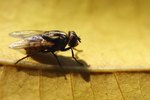Most people know think that those cute little caterpillars they see every spring will turn into beautiful butterflies when they grow up. However, this is not the case. The fact is most caterpillars turn into moths and it’s not by a small margin either. The ratio of moths to butterflies is 95% to 5%. (See resources for more information.) Both butterflies and moths are in the order Lepidoptera and share a similar reproductive cycle.
Attracting a mate
While butterflies find mates by sight, moths use their sense of smell. This is because they usually come out at night and they are pretty drab and gray to begin with, making them hard to spot, even to one another. The female moth produces pheromones that the male moth picks up on. Once the male discovers the scent with his antennae, he flies toward the source of it and ultimately locates his lady love.
Mating
The male and female moths attach together at their abdomens, with the male using his “claspers,” which are short, hand-like appendages on his anus, to hold on to the female. (This way they can continue to mate even if they have to move to another tree branch to escape a predator.) Then he passes a sac, known as the "spermatophore," through his penis. The spermatophore contains not only sperm but also nutrients to help support the developing larvae. The female stores the sac in her abdomen’s reproductive center, called the "bursa copulatrix." She can mate with several males in succession before laying her eggs. There is no sense of monogamy in the moth world.
Laying eggs
Female moths have eggs stored in their bodies. Shorty after the male’s sperm fertilizes these eggs, she will lay them. Some species, like the cecropia, can lay more than 100 eggs at one time. In most cases, she takes care to deposit them near a food source for her young, such as a leaf. They hatch anywhere from a couple days to a couple months later, depending on the species of the moth and environmental conditions. For example, if it is too cold outside to sustain the young, the eggs may not hatch until the weather warms up.
Growing up
The moth caterpillars feed and grow until they’re ready to form cocoons. They must go through metamorphosis and become adults before searching for mates of their own.
Resources





